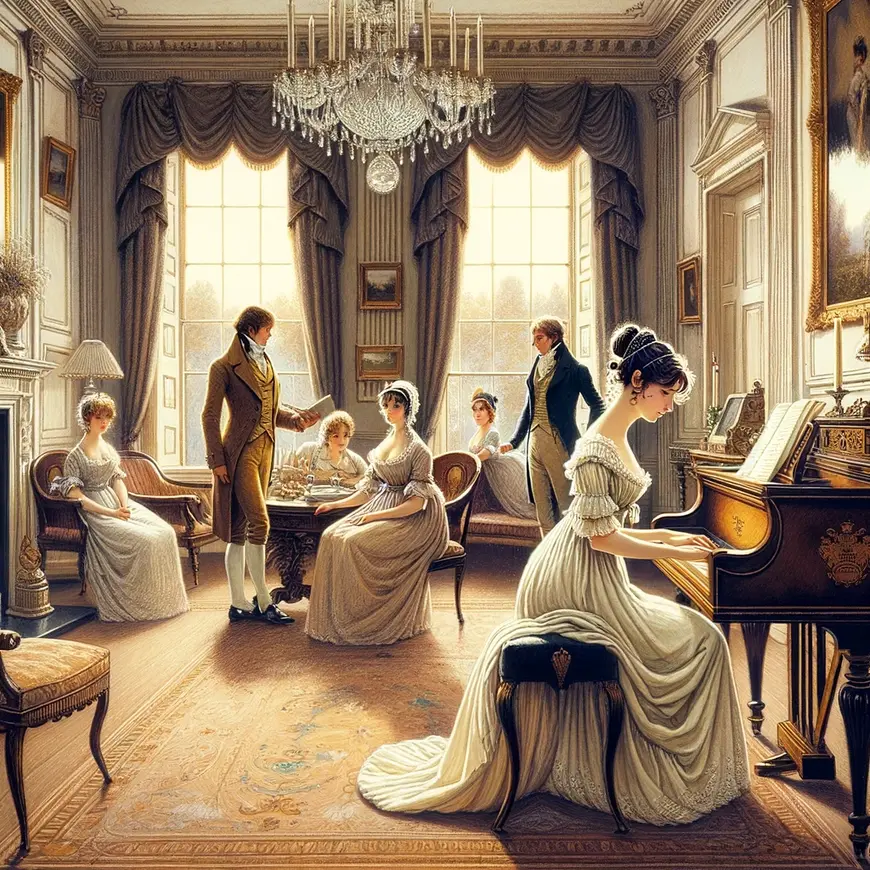A Timeless Tale of Love and Self-Discovery – A Review of Jane Austen’s “Emma”
Quick Summary: My Thoughts on Emma by Jane Austen
Reading Emma by Jane Austen, it really started to dawn on me just how I was being drawn into all of these social webs characteristic of early 19th-century England. The novel circles around Emma Woodhouse, a young woman of considerable intelligence and fortune but with poor judgment capacity, especially in making matches within her little society at Highbury.
Mainly, I liked the fact of how witty and ironical Austen was in her criticism of the social class and gender roles. During this read, I was accompanying Emma through the process of being an overconfident person who fully knew the hearts of others to become someone humbler and more self-aware. Every turn to the point of reading was a lot of fun, filled up with the lively dialogues and complicated interrelationships between the characters.
Setting and period details created absolutely delightful and enriching scenery for the whole experience. Watching Emma’s errors in judgment unfold to grow and develop real understanding and empathy gave me an extremely valuable insight into the development of human nature and personal growth.
In the treasure trove of classic literature, Jane Austen’s “Emma” sparkles as a gem of timeless charm and wit. With prose that is as sharp as it is heartwarming, Austen weaves a narrative that delves into the world of matchmaking, manners, and the transformative journey of a young woman discovering herself. As relevant today as it was in the 19th century, “Emma” remains a delightful exploration of human nature, relationships, and the quest for love.
Unveiling the Intricacies of Social Circles: The World of “Emma”
Imagine a world of picturesque English villages and genteel society, where social conventions dictate the ebb and flow of daily life. “Emma” immerses us in this world, where the charming and clever Emma Woodhouse takes center stage. Austen’s narrative allows us to accompany Emma on her journey through the intricacies of matchmaking, class, and manners in a society where every glance, word, and gesture carries significance.
The setting of “Emma” becomes more than a backdrop; it’s a character in itself. The fictional village of Highbury is meticulously portrayed, with its country houses, gardens, and ballrooms. Austen’s prose captures the essence of rural England, creating an atmosphere that is both nostalgic and inviting.

Characters in the Spotlight: A Delightful Ensemble
At the heart of “Emma” is the titular heroine, a young woman who, while charming and clever, harbors a penchant for matchmaking. Her journey of self-discovery forms the core of the narrative. Around her, an ensemble of characters including Mr. Knightley, Mr. Elton, and Harriet Smith provides a delightful array of personalities, each contributing to the tapestry of manners and relationships.
Themes of Love, Self-Discovery, and Manners: Insights Explored
“Unraveling the tapestry of love, self-discovery, and manners,” Austen seems to say as she delves into themes that remain universally relevant. Love is central to the narrative, as Emma engages in matchmaking while remaining oblivious to her own heart’s desires. Austen’s exploration of love is not limited to romantic love; it encompasses the love between friends and family, and the subtleties of human emotion.
Self-discovery is another prominent theme that runs through “Emma.” The narrative follows Emma’s transformation from a well-intentioned but sometimes misguided young woman into a more self-aware and compassionate individual. Her journey reminds readers that true growth often involves introspection and a willingness to acknowledge one’s flaws.
Manners and social conventions are also at the heart of “Emma.” Austen dissects the intricacies of polite society, where the tiniest deviations from decorum can be subject to scrutiny. The narrative prompts readers to consider the role of manners in society, both in Austen’s time and today.
Prose as a Satirical Elegance: Austen’s Writing Style
Jane Austen’s writing style in “Emma” is a tapestry of satirical elegance. Her prose is full of wit and incisive observations. It offers a window into the manners and mores of her time. Her language is both polished and playful. This creates an atmosphere that is engaging and comically observant.
Moreover, the novel’s structure is carefully crafted. Each chapter reveals a new layer of the characters’ personalities and drama. Austen’s writing style mirrors the social intricacies of the narrative. Every dialogue and interaction is laden with subtext. This creates a narrative that is both charming and insightful.
Timeless Relevance: Today’s Reflections
While “Emma” is set in a specific historical period, its themes remain relevant today. It explores love, self-discovery, and manners in a profound way. In an era of complex relationships and societal norms, Austen’s examination of these themes offers a timeless perspective.
The theme of love, with its nuances and challenges, continues to resonate. Individuals grapple with the evolving landscape of romantic and familial relationships. Austen’s portrayal of Emma’s transformation serves as a reminder. Self-discovery is a lifelong journey, and growth arises from recognizing one’s limitations.
Manners and societal norms, though evolved, still play a vital role in human interactions. “Emma” prompts readers to reflect on the significance of politeness. It highlights the unspoken rules that govern our interactions with others. Austen’s satirical observations remain a source of amusement and insight.

Famous Quotes from “Emma” by Jane Austen
- “I always deserve the best treatment because I never put up with any other.”
- Explanation: This quote is spoken by Emma Woodhouse, the protagonist. It reflects her confidence and sense of self-worth. Emma’s assertive attitude is a key aspect of her character, though it also highlights her occasional arrogance and social privilege.
- “If I loved you less, I might be able to talk about it more.”
- Explanation: Mr. Knightley says this to Emma in a moment of deep emotional honesty. It reveals his sincere and profound love for her, which he finds difficult to express with words. This quote underscores the theme of unspoken affection and the complexity of their relationship.
- “Silly things do cease to be silly if they are done by sensible people in an impudent way.”
- Explanation: This quote reflects Austen’s wit and social commentary. It suggests that actions considered frivolous or foolish can be perceived differently depending on who performs them and how. It’s a reflection on societal norms and the influence of personality and reputation.
- “There are people, who the more you do for them, the less they will do for themselves.”
- Explanation: Emma’s father, Mr. Woodhouse, says this. It captures a central theme in the novel: the balance between helping others and encouraging their independence. This quote reflects Mr. Woodhouse’s concern for others, though it also hints at his overly cautious and somewhat indulgent nature.
Trivia Facts about “Emma”
- Set in Highbury: “Emma” is set in the fictional village of Highbury. Austen modeled it after real English villages she knew.
- Admired by Charlotte Brontë: Charlotte Brontë, author of “Jane Eyre,” admired Austen’s writing. She praised Austen’s keen observations of social manners.
- Influence on George Eliot: George Eliot, famous for “Middlemarch,” was influenced by Austen. Eliot appreciated Austen’s detailed character studies.
- Austen’s Chawton Home: Jane Austen wrote “Emma” while living in Chawton. Her house there is now a museum dedicated to her life and works.
- Published in 1815: “Emma” was published in 1815 in London. The city’s literary scene was vibrant, with authors like Sir Walter Scott and Lord Byron active at the time.
Final Thoughts on “Emma” : An Austenian Delight of Wit and Wisdom
“Emma” is a delightful mix of wit and wisdom. It invites readers to immerse themselves in matchmaking, manners, and the quest for love. Jane Austen’s narrative shows the power of character-driven storytelling. It explores how individuals navigate relationships and self-discovery.
As readers journey through “Emma,” they see the power of literature. It challenges our understanding of love and manners and it invites us into the lives of endearing characters. It prompts us to reflect on timeless themes of human nature. Moreover, Austen’s prose serves as a vessel for contemplation. Readers can ponder the pursuit of love, self-discovery, and the nuances of polite society.
“Emma” stands as a testament to the enduring relevance of its themes. These themes have fascinated readers for centuries. The novel invites us to navigate the labyrinth of manners and relationships. It does so with both delight and reverence.
Reviews of other Works by Jane Austen
“Northanger Abbey” by Jane Austen: A Delightful Satire on Love, Literature, and the Allure of Imagination Jane Austen’s “Northanger Abbey”…
Jane Austen’s Unfinished Gem – “Sanditon” In the world of classic literature, Jane Austen’s name sparkles like a literary gem,…
Navigating the Social Labyrinth – A Review of Jane Austen’s “Mansfield Park” Austen’s Complex Portrait of Society – Exploring the…
Love and Reason: The Tale of “Sense and Sensibility” by Jane Austen “Sense and Sensibility” by English writer Jane Austen…
“A Timeless Tale of Love and Misunderstandings: Pride and Prejudice by Jane Austen” “Pride and Prejudice” is a classic novel…




